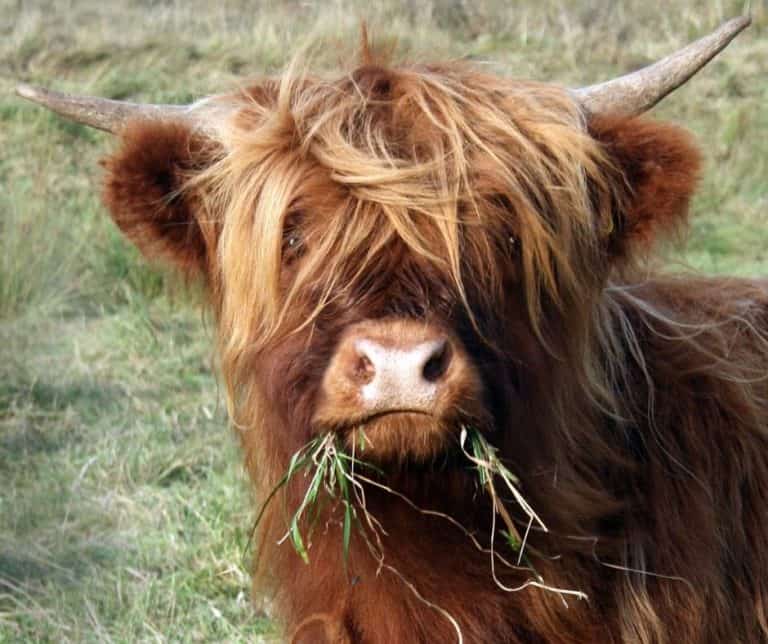Scottish Heather
More than meets the Eye
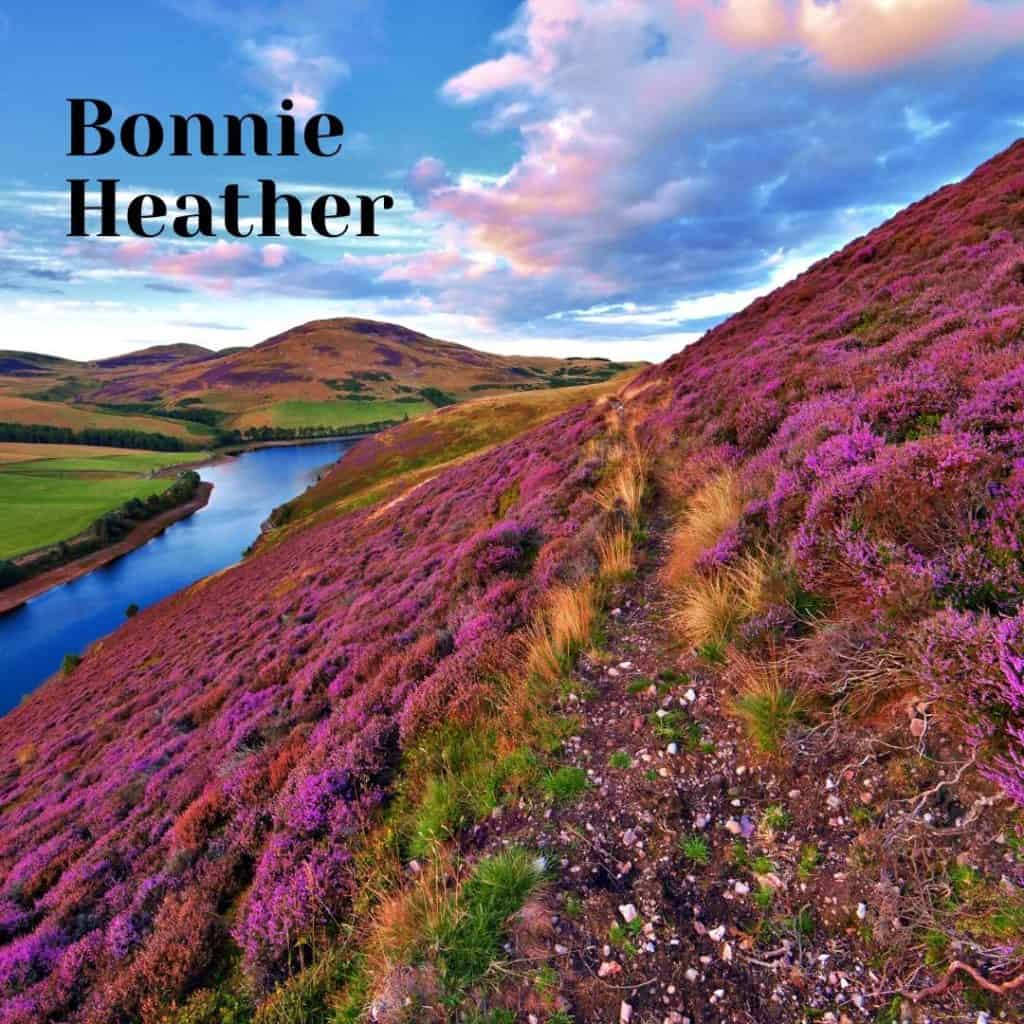
Once I was old enough, I used to work my Summer Holidays from School on the Grouse Moors that surround Royal Deeside in rural Aberdeenshire.
I was a beater. A beater is someone that the shooting estates employ to help drive the Red Grouse forward whilst walking the many miles on the sides of the hills and mountains.
In my first outings, I could never understand how the estate’s shooting staff employed full time as gamekeepers could move around from one end of a line to the other, which was often a mile or more at twice the speed as everyone else.
The moors are covered with Heather, and the thick tufts of Heather are a nightmare to walk on, and many people have had bad sprains as the heather tufts catch you out.
But not the keepers. They seemed to sort of glide. After a few seasons, I also developed the technique of using the top of the Heather as mini-trampolines and bounce between them.
This movement style over the Heather is called a Heather-Lamp, and the person doing it was a Heather-Lamper

From the Scots Dictionary
Lamp – “To take long, springing or prancing steps, to stride, to step out, to walk smartly and deliberately.”
By this time, I had been promoted and was in charge of one end of the line, meaning; I also had to glide my way from one end to the other even before the lines started. So I just Heather Lamped over the Scottish Heather from one end to the other.
Many of the drives were 2 or 3 miles walk; drives were usually five a day plus the walk to the start of the next one.
The fitness I gained on the grouse moors gave me a good start when I later joined the marines in 1979 – yep, I am that old, haha. You can read more about me here
Happy days
As far as the eye can see
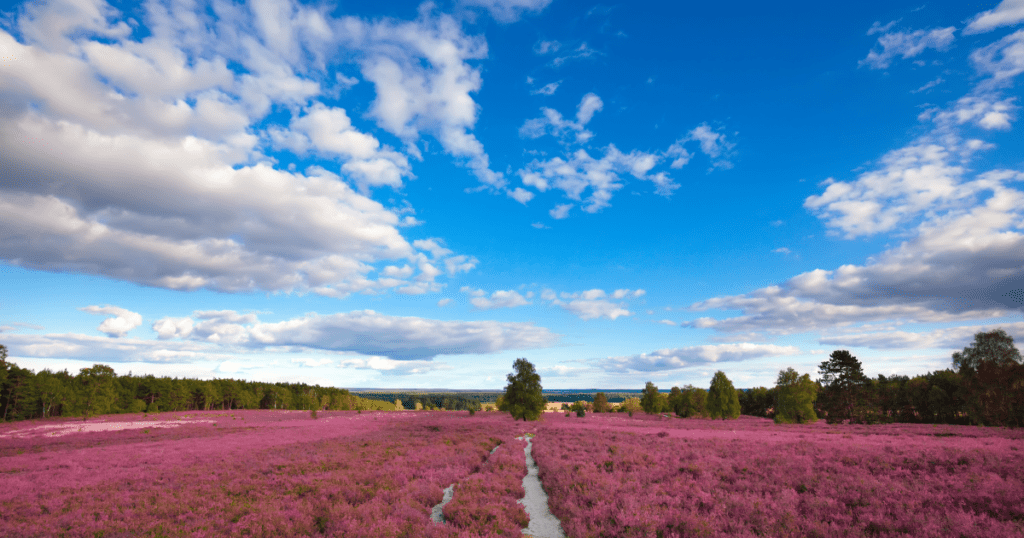
Once you leave the cities, especially if you are heading north, you are going to encounter some dramatic scenery, and if it is during the time Heather is blooming, then you will be greeted with an explosion of colours as far as the eye can see
Heather blooms sometime between June and October.
For me, when the Scottish Heather blooming coincides with the landscape starting to put on its autumn coat, the result can be mesmerising, and very few people have managed to capture it with a camera or paint.
So that’s it then Heather is a colourful mini-trampoline.
Thank you for reading
Stop – back up, and let’s look again.
First of all, when you look over the hills wrapped in Heather, you are seeing more than one species of Heather – up to three, although two are called “heath”
So what are the three
- Common Heather
- Crossed Leafed (heath)
- Bell Heather (heath)
- Crossed Leafed (heath)
(Bell Heather is also a “heath” but has Heather in the name to confuse us ordinary folk)
Let’s make you a Scottish heather expert.
The Common Heather is the more robust of the three and can grow just about anywhere and will grow further up the mountain in the cold and less agreeable soil.
The common Heather also has muted colours compared to the two heaths, with a deep purple that turns the high slopes into an almost alien landscape in late summer.
The colour is only noticeable when there is a blanket of common Heather, individual plants are easily missed.
It’s the heaths that give the variations on colour, that patchwork of splashed white, to pink to red, with the Bell heather showing the most vibrant colours
Shall we take it further?
Let’s make you into a smarty pants able to impress your friends and family by leaping out of the car, grabbing a handful of Heather, investigating closely and confidently declaring the name in a knowing manner.
First, you need to decide if it is Heather or Heath. Remember Heather is called ‘Common Heather,’ and the two heaths are ‘Bell Heather’ and ‘Crossed Leaf.’
First, look at the stalk – if the flowers are bell-shaped and at the end of the stem, you have a heath, either Bell or Cross leaf.
If the flowers do not reach the end of the stalks and the petals are not arranged in a bell shape and the petals are separate then you have common Heather, sometimes referred to as Ling.
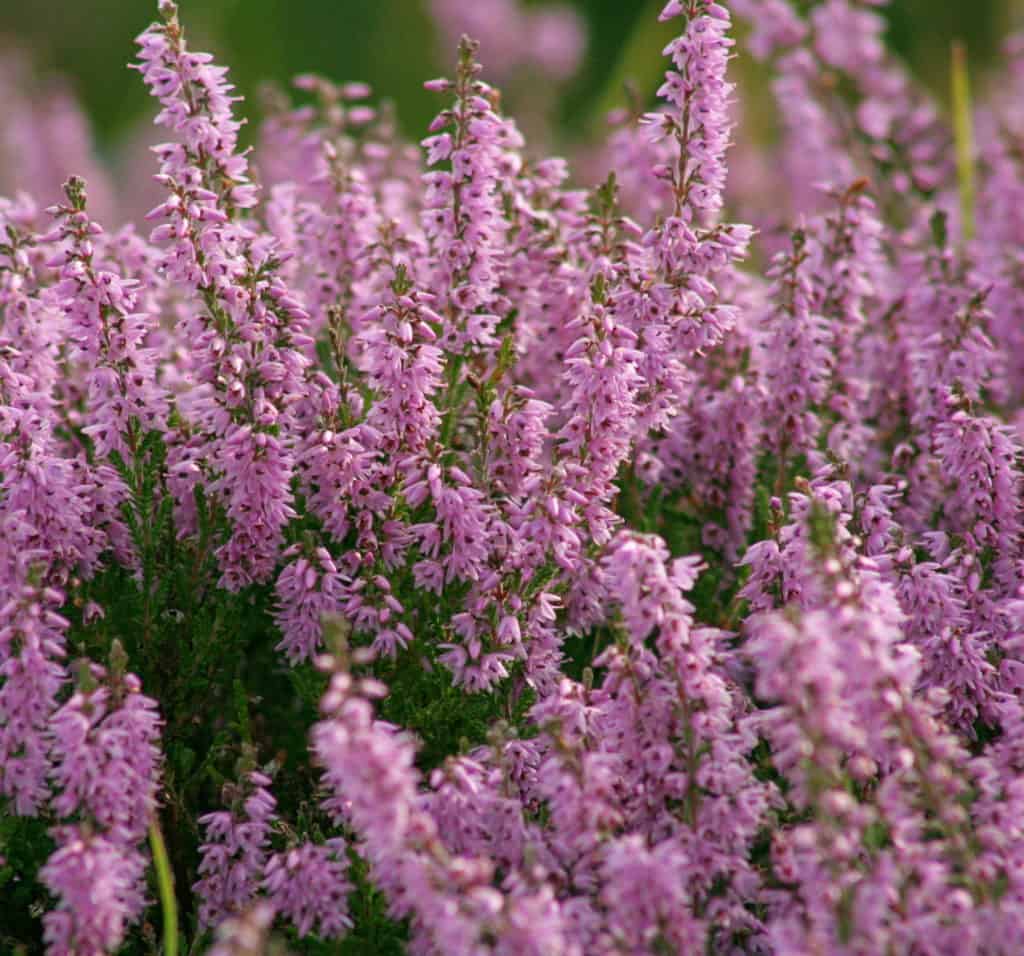
Now you can set aside your common Heather or Ling and concentrate on the Heaths.
Look below the Bellflowers, and you will see the green leaves.
Cross Leaf have clumps of four leaves growing out of the stalk, and with good eyes, you can also see the leaves are hairy.
It is these hairs that dull the colour of the cross Leaf when seen from a distance.
An easy way to remember is – if you were covered in hair you would be “Cross”
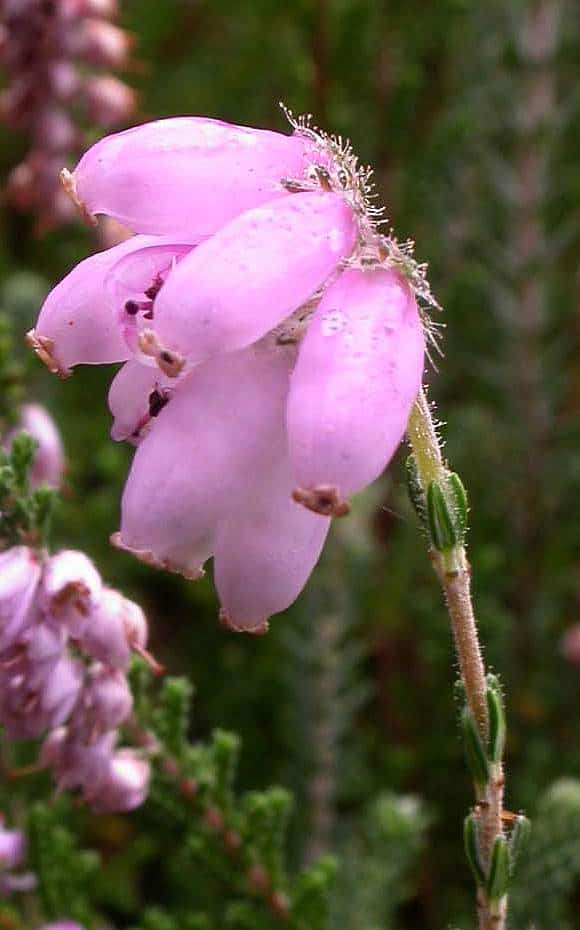
The Bell Heather has only three leaves and no hair.
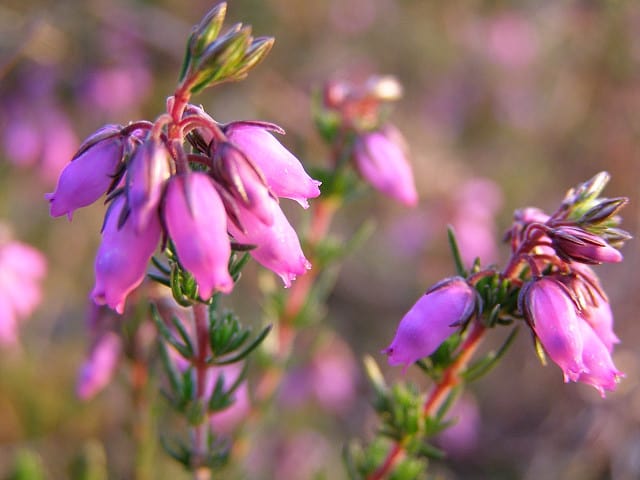
Bell Heather is no fan of boggy ground, but cross leafed love it
This means when you are surveying a potential route, stay clear of the Heather that is not so bright, and stay on the side of the more colourful Heather because the Cross Leafed hairy heath (say that 3 times fast) is duller in colour due to the hairs
You have a better chance of keeping your boots dry.
Tired – maybe you need to lay down.
Heather has been used to make a sleeping mattress. Not the style that you would buy in a store today but an open Mattress
Long lengths of dried, flowering Heather were placed together in the bed frame, flowers to the top and facing the bed head.
A quote from a 16th Century tutor to the Royals
“so pleasant, that it may vie in softness with the finest down, while in salubrity it far exceeds it … and restores strength to fatigued nerves, so that those who lie down languid and weary in the evening, arise in the morning vigorous and sprightly.”
The Skara Brae excavation in Orkney islands has evidence of beds, in the form of stone boxes, lined with either Heather or straw from 2000 BC.
So if you’re getting on in age as I am and want to
“arise in the morning vigorous and sprightly.”
Best we make a Heather Bed
Cold
Even today, crofters and farmers rely upon Heather as an abundant and efficient fuel for their fires. The layers of a peat bog often have Heather.
The small heather stems were also used as they were found to make good kindling to get the fire started.
The charred stalks were also used for writing.
Building
Heather is used for thatching roofs and mixed with mud/clay to make walls. Many Church walls were formed in this way.
The thatched roofs are said to last 100 years and are still used today on many islands. A ‘heatherer does the thatching of roofs.’
In the ‘General View of Agriculture of Argyll (1798)”, Mr J Smith says
“Heather roofs are more suited to Farmhouses, as they, along with our ordinary timber, can be had for a trifle, last almost as long as slates, and give less trouble in repairs.”
He goes on to say
“It is astonishing that, in a country in which Heather abounds, these roofs are not more common. They are indeed heavier than straw roofs; but by making them a little steeper, and placing the couples a little nearer than ordinary roofs, most of the weight will be thrown on the walls, which, if made as they ought to be, of stone and lime, will not feel the burden. It makes a neat warm, and durable roof.”
‘General View of Agriculture of Argyll (1798)”, Mr J Smith
No need for Amazon Delivery
Some other uses that Heather was/are routinely used for
- Baskets
- Rope
- Brooms and brushes
- Pot Scrubbers
- Doormats
- Pot Scrubbers
- Brooms and brushes
- Rope
The people who sold these items from door to door were called “Heather Jennys” or “Heather Jocks.”
Hungry – Thirsty
Highland Park is a renowned whisky made in Kirkwall on the Islands of Orkney.
This is a partial description taken from ‘Whiskipedia.’
“On our way, we noticed a peculiarly shaped timber building, which our guide informed us is called the “Heather House.”
Here Heather is stored, which has been gathered in the month of July when the blossom is fully set. It is carefully cut off near the root and tied into small faggots of about a dozen branches.
One or two of these faggots are used with the peat in drying the malt every time the fire is made up, and imparts a delicate flavour of its own to the malt, rendering Highland Park Whisky unlike any other made in the kingdom.”
Heather Honey
Heather Honey is well known and sort after the world over. The beekeepers bring the hives to the hills once the Heather starts to bloom, and the bees turn the heather nectar into Honey.
Bell Heather honey produces Honey with a port wine colour and a strong characteristic flavour.
Cross Leaved Heath makes Honey which is much thinner and lighter in colour.
Tea anyone – “Tinkers Tea.”
Fishermen having a day on the loch would make heather tea.
Fill the kettle with loch water and take it to the shore. Add a sprig of Heather and tea.
Next, burn old dry Heather under the kettle and make a mound of Heather over the kettle.
By the time it has burnt out, the tea is ready with a heathery flavour.
Beer Perhaps
There are many recipes for heather beer, both old and modern. If you are a homebrewer, take a look on the internet and see what you can do.
Or perhaps wine – try here.
Heather ale was made in Scotland for thousands of years – archaeologists have found traces of an alcoholic drink made from Scottish Heather on shards of pottery more than 3,000 years old.
What with whisky, beer and wine it’s a pity that we can not add ‘Hangover Cure” to the list of healing properties coming next
Healing Heather
Since 1543 it has been documented that Heather has healing properties for various ailments, including
- Ulcers – Internal and external
- Insect Bites
- Snake Bites
- Eye Infections
- Spleen maladies
- Prevention of the formation of stones
- Hay fever
- Prevention of the formation of stones
- Spleen maladies
- Eye Infections
- Snake Bites
- Insect Bites
Heather has even been found to help nursing mothers produce more milk.
Cool stuff this Scottish Heather
Not just Humans benefits
Many animals depend significantly on Heather for survival. – Red Deer, Rabbits and Hares, eat the young shoots and is an important supplement
Many food chains start with Heather, for example.
Caterpillars eat the young shoots feasted on by the Meadow Pipet, which is preyed upon by the Hen Harrier.
This diverse food source is good all year.
In summer, the flowers are eaten, in bud and bloom, along with the seed heads. And in autumn, even the seed capsules help to sustain wildlife on the moor.
The Red Deer browse heavily on the Heather, particularly in the winter months when other food is hard to find.
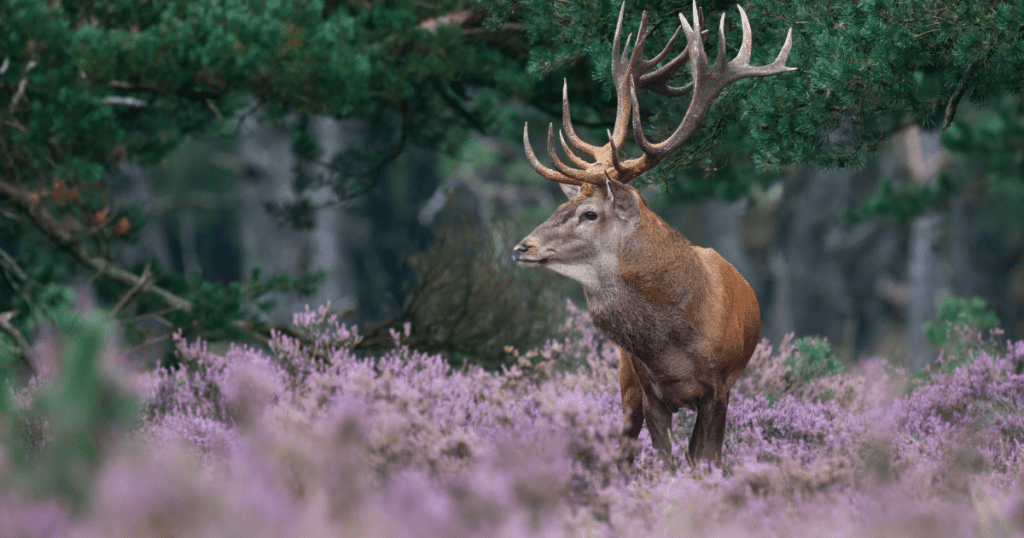
The Roe Deer also graze on the plant, preferring to stay in the longer Scottish Heather.
Domestic animals too, such as cattle and sheep, also benefit from grazing on Heather. The blackfaced sheep are taken especially to the Heather to give the lambs a unique flavour and is officially recognised as one of Scotland’s gourmet tastes, comparable with Grouse, venison, whisky and salmon.
Cattle use the Heather to supplement their winter diet of hay, turnips and manufactured foods.
However, it is perhaps the hardiest of domestic breeds, the primary beneficiary – the Blackface sheep. For many years to the present day, sheep farmers have taken their sheep to the Heather to give the resultant lamb ‘that special flavour’.
Indeed the Blackface Sheep Breeders Association is pushing hard to have the pure-bred ‘Blackface Lamb from the Heather’, officially recognised as one of Scotland’s gourmet tastes, comparable with Grouse, venison, whisky and salmon.
A Haven for birds
The bird most associated with Heather is the Red Grouse,
Apart from nesting time, when the bird feeds primarily on insects and grubs, the Grouse will feed on young heather shoots.
Breeding tends to be more successful on more nutritious Heather.
Of course, Heather is more than just a food source, and Heather is also a natural habitat for the hundreds of different insects, animals and birds, all of whom are interdependent.
Red Grouse: Relies on Heather not just for food but also as a protective cover from predators such as the Golden Eagle and Peregrine Falcon.
Other Birds that take full advantage of Heather are
- Black Grouse
- Ptarmigan
- Capercaillie
- Golden Plover
- Dotterel
- Lapwing
- Curlew
- The Common Snipe
- Ring Ouzel
- The Meadow Pipit: Also known as the Heather-Cheaper
- The Heather Lintie
- The Heather Peeper: Another name for the Common Sandpiper
- The Heather-Cun-Dunk: A sea bird
- Golden Eagle
Other birds of prey associated with the Heather include the Buzzard, Peregrine Falcon, the Merlin, Hen Harrier and Short Eared Owl.
Hey don’t go yet!
Let’s look at some Myths and Legends.
The King & Heather Ale:
A well-known legend involves a confrontation between Viking raiders and the last surviving Pictish King somewhere around the 4th century. Still, it is more likely to be from the 8th century.
After the Pictish army loses the battle, the Pictish King and his son find themselves cornered on a cliff-top where the Viking chief tortures them in an attempt to obtain the secret recipe for Heather Ale.
This King has a quick think to himself and concludes his son is likely to give the recipe under torture.
So he strikes a deal with the chief Viking. ‘Kill my son quick with no torture, and I will give you the secret to Heather Ale.
Mr Viking agrees and despatches the King’s son.
“Sucker,” says the King. My son might have told you, but I never will.
The King is thrown off the cliff to his death, but some versions say he took the Viking chief with him.
The secret of Heather Ale.”Robert Louis Stevenson
From the bonny bells of heather
They brewed a drink long-syne,
Was sweeter far than honey,
Was stronger far than wine.
They brewed it and they drank it,
And lay in a blessed swound
For days and days together
In their dwellings underground.
There rose a king in Scotland,
A fell man to his foes,
He smote the Picts in battle,
He hunted them like roes.
Over miles of the red mountain
He hunted as they fled,
And strewed the dwarfish bodies
Of the dying and the dead.
Summer came in the country,
Red was the heather bell;
But the manner of the brewing
Was none alive to tell.
In graves that were like children’s
On many a mountain head,
The Brewsters of the Heather
Lay numbered with the dead.
The king in the red moorland
Rode on a summer’s day;
And the bees hummed, and the curlews
Cried beside the way.
The king rode, and was angry,
Black was his brow and pale,
To rule in a land of heather
And lack the Heather Ale.
It fortuned that his vassals,
Riding free on the heath,
Came on a stone that was fallen
And vermin hid beneath.
Rudely plucked from their hiding,
Never a word they spoke:
A son and his aged father—
Last of the dwarfish folk.
The king sat high on his charger,
He looked on the little men;
And the dwarfish and swarthy couple
Looked at the king again.
Down by the shore he had them;
And there on the giddy brink—
“I will give you life, ye vermin,
For the secret of the drink.”
There stood the son and father
And they looked high and low;
The heather was red around them,
The sea rumbled below.
And up and spoke the father,
Shrill was his voice to hear:
“I have a word in private,
A word for the royal ear.
“Life is dear to the aged,
And honour a little thing;
I would gladly sell the secret,”
Quoth the Pict to the King.
His voice was small as a sparrow’s,
And shrill and wonderful clear:
“I would gladly sell my secret,
Only my son I fear.
“For life is a little matter,
And death is nought to the young;
And I dare not sell my honour
Under the eye of my son.
Take him, O king, and bind him,
And cast him far in the deep;
And it’s I will tell the secret
That I have sworn to keep.”
They took the son and bound him,
Neck and heels in a thong,
And a lad took him and swung him,
And flung him far and strong,
And the sea swallowed his body,
Like that of a child of ten;—
And there on the cliff stood the father,
Last of the dwarfish men.
“True was the word I told you:
Only my son I feared;
For I doubt the sapling courage
That goes without the beard.
But now in vain is the torture,
Fire shall never avail:
Here dies in my bosom
Ready for another Sad tale
White Heather Is Lucky For Brides
A bride to be, Malvina (daughter of the legendary Scottish poet, Ossian) was betrothed to Oscar, a Celtic warrior.
Conveniently for this story, Oscar gets killed in battle before they can be wed.
When the Messenger tells Malvina the sad news, he gives her a sprig of purple Heather from Oscar as his final love gift.
When Malvina’s tears fall on the purple Heather, it is transformed to White, and as she walks over the moors, tears fall upon patches of purple Heather, also turning them white.
Even in the depths of her sadness, wishing that others might be happier than she, Malvina prayed,
“May the White Heather, a symbol of my sorrow, bring good fortune to all who find it.”
But that’s just one theory behind “Lucky White Heather.”
White Heather grows over the final resting places of faeries is another
There was also a belief that white Heather grew where no blood had been shed in a country of many ancient battles.
Rounding Off now
Now you will be gazing at the heather-covered hills with new knowledge and perhaps a little surprise for what Heather is and how it is linked to Scotland.
While you are gazing, you might notice strips of black burned ground that is uniform in shape.
In Scotland, Old Heather is burned, generally in the spring, every 10 to 15 years.
The fire is well controlled and not allowed to burn too hot.
This allows the new Heather shoots to come through to benefit man, beast, animal, bird, insect and reptile.
I will leave you with this last thought.
When God first made the world, He looked at the bare and barren hillsides and thought how nice it would be to cover them with some kind of beautiful tree or flower.
So he turned to the Giant Oak, the biggest and strongest of all of the trees he had made, and asked him if he would be willing to go up to the bare hills to help make them look more attractive.
But the oak explained that he needed a good depth of soil in order to grow and that the hillsides would be far too rocky for him to take root.
So God left the oak tree and turned to the honeysuckle with its lovely yellow flower and beautiful sweet fragrance.
He asked the honeysuckle if she would care to grow on the hillsides and spread her beauty and fragrance amongst the barren slopes.
But the honeysuckle explained that she needed a wall or a fence or even another plant to grow against, and for that reason, it would be quite impossible for her to grow in the hills.
So God then turned to one of the sweetest and most beautiful of all the flowers – the rose. God asked the rose if she would care to grace the rugged highlands with her splendour.
But the rose explained that the wind and the rain and the cold on the hills would destroy her, and so she would not be able to grow on the hills.
Disappointed with the oak, the honeysuckle and the rose, God turned away. At length, he came across a small, low lying, green shrub with a flower of tiny petals -some purple and some white.
It was a heather.
God asked the Heather the same question that he’d asked the others. “Will you go and grow upon the hillsides to make them more beautiful?”
The Heather thought about the poor soil, the wind and the rain – and wasn’t very sure that she could do a good job.
But turning to God she replied, that if he wanted her to do it, she would certainly give it a try.
God was very pleased.
He was so pleased in fact that he decided to give Heather some gifts as a reward for her willingness to do as he had asked.
Firstly he gave her the strength of the oak tree – the bark of the Heather is the strongest of any tree or shrub in the whole world.
Next, he gave her the fragrance of the honeysuckle – a fragrance which is frequently used to gently perfume soaps and potpourris.
Finally, he gave her the sweetness of the rose – so much so that Heather is one of the bees favourite flowers.
And to this day, Heather is renowned especially for these three God-given gifts.
So there you are another reason to visit Scottland see the Scottish heather if you need more reason then take a look at this article
As always I am happy to read your comments. Please leave me your thoughts below or come along to my Facebook page or use the contact page if you prefer


